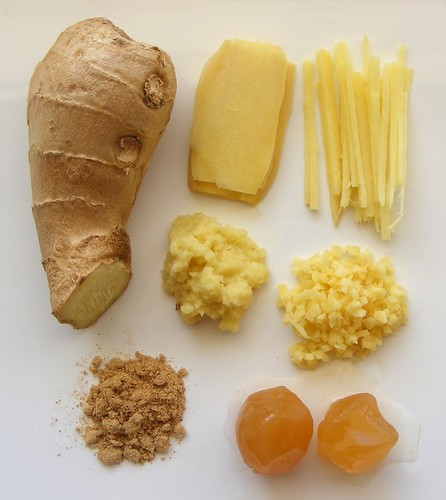Ginger
The Basics

Like yams, sweet potatos and cassava; ginger is a tuber (a modified part of the plant stores its nutrition for the growing season). Ginger, however, is a rhizome which means it grows via an underground stem. Botany lesson aside, when you eat ginger you are eating the root of Zingiber officinale, which is where this beauty stores its nutrients and energy for the the dry months.
The skin of the ginger root is a is light tan with a goldish, opalescent hue and a perky, yellow interior. Young roots are tender whereas the older roots are more fiberous but whose juices are very potent.
The Form
Pickled, preserved, powdered, stewed, crystallized or juiced; ginger lends itself to diversity. The young, tender, ginger root can be sliced and pickled (sushi lovers know pickled ginger as the sumptuous, curvy pile of pink or white ribbons on their plate). It’s also boiled to make ginger tea which is drunk with a little honey or sugar added to it. In its whole form or sliced, young ginger is used to flavor vinegars and spirits like sherry. Crystallized ginger is when the young root is soaked, coated and dried with sugar crystals. This form can be eaten plain like candy or used as an ingredient. The golden powder so many of us reach for in our spice drawers is made by taking the ginger root, drying and grinding it into a powder. The older roots are more fiberous but the the juices have a concentrated potency which is valued as a cooking ingredient.
The Flavor
If a hot summer sun on a tropical beach had a flavor it would be ginger. Ginger is vibrant with a warm, sweet, spicy flavor capable of soothing the palate or biting it with heat. It complements many flavor families including other spices like cardamom, cinnamon, nutmeg, and allspice. It warms up broth, spices up tea and pairs well with honey, sugar, bittersweet chocolate and nuts. It’s a flavor chameleon, acting like candy in one mouth while spicing up a savory soup for another.
Like most spices, ginger should be stored in an airtight container away from heat and light. If you just need the juice for a recipe try freezing the root-then letting it thaw. Then you can cut and easily squeeze out the juice.
The Story
Ginger has an international audience. Forgive me while I shamelessly borrow from Wikipedia for this section:
In India, ginger is called Aadrak in Bengali, Punjabi and Urdu, Adu, in Gujarati, Shunti in the Kannada , Allam (అల్లం) in Telugu, Inji in Tamil and Malayalam, Alay in Marathi, and Aduwa in Nepali, in somaliland,ginger is called Sinjibil
Fresh ginger is one of the main spices used for making pulse and lentil curries and other vegetable preparations. It is used fresh to spice tea especially in winter. Ginger powder is also used in certain food preparations particularly for pregnant or nursing women, the most popular one being Katlu which is a mixture of gum resin, ghee, nuts, and sugar.
In South India, ginger is used in the production of a candy called Inji-murappa meaning ginger candy in Tamil. This candy is mostly sold by vendors to bus passengers in bus stops and in small tea shops as a locally produced item. Candied or crystallised ginger (ginger cured with sugar) is also common. Additionally, in Tamil Nadu, especially in the Tanjore belt, a variety of ginger which is less spicy (also known as mango ginger because of the raw mango-like flavor it renders) is used when tender to make fresh pickle with the combination of lemon juice or vinegar, salt, and tender green chili peppers. This kind of pickle was generally made before the invention of refrigeration and stored for a maximum of 4–5 days. The pickle gains a mature flavor when the juices cook the ginger over the first day. Ginger is also added as a flavoring in tea. Dried ginger (sukku சுக்கு) is used in tea or coffee and also in siddha medicine.
In Bangladesh, ginger is called Aadha and is finely chopped or ground into a paste to use as a base for chicken and meat dishes alongside onion and garlic.
In Burma, ginger is called gyin. It is widely used in cooking and as a main ingredient in traditional medicines. It is also consumed as a salad dish called gyin-thot, which consists of shredded ginger preserved in oil, and a variety of nuts and seeds.
In Indonesia a beverage called Wedang Jahe is made from ginger and palm sugar. Indonesians also use ground ginger root, called jahe as a common ingredient in local recipes.
In Vietnam, the fresh leaves finely chopped can also be added to shrimp-and-yam soup (canh khoai mỡ) as a top garnish and spice to add a much subtler flavor of ginger than the chopped root.
In China, sliced or whole ginger root is often paired with savory dishes such as fish. However, candied ginger is sometimes a component of Chinese candy boxes, and a herbal tea can also be prepared from ginger.
In Japan, ginger is pickled to make beni shoga and gari or grated and used raw on tofu or noodles. It is also made into a candy called shoga no satozuke.
In the traditional Korean kimchi, ginger is finely minced and added to the ingredients of the spicy paste just before the fermenting process.
In Western cuisine, ginger is traditionally used mainly in sweet foods such as ginger ale, gingerbread, ginger snaps, parkin and ginger biscuits. A ginger-flavored liqueur called Canton is produced in Jarnac, France. Green ginger wine is a ginger flavored wine produced in the United Kingdom, traditionally sold in a green glass bottle. Ginger is also used as a spice added to hot coffee and tea.
In the Caribbean, ginger is a popular spice for cooking, and making drinks such as sorrel, a seasonal drink made during the Christmas season. Jamaicans make ginger beer both as a carbonated beverage and also fresh in their homes. Ginger tea is often made from fresh ginger, as well as the famous regional speciality Jamaican Ginger Cake.
On the island of Corfu, Greece, a traditional drink called τσιτσιμπύρα (tsitsimpira), a type of ginger beer, is made. The people of Corfu and the rest of the Ionian islands picked up the drink from the British, during their occupation of the islands.
In Arabia, ginger is called zanjabil and in some parts of the Middle East ginger powder is used as a spice for coffee.
In the Ivory Coast, ginger is ground and mixed with orange, pineapple and lemon to produce a juice called Nyamanku.
Health Benefits
Ginger’s medicinal uses are as widespread as its culinary value. Many people find ginger as a relief for nausea and upset stomachs. It’s used as an aid for digestion and cough suppressant. Stuides have attributed gingerol, one of ginger’s volatile oils with antimicrobial qualities. It can act as a food preservative and kill the bacteria salmonella. Ginger has also been shown to possible reduce arthritic pain.
Try It!
Absolutely Ultimate Gingerbread
Forget cakey, flakey wimpy gingerbread. This version is dark, dense, sticky and insanely addictive. It actually improves if it gets to sit for a day but no one can wait that long before diving into it. The recipe is adapted from The Bread Book. Please learn from my mistakes: take the pan measurements seriously. I had to deal with an pan overflow that produced more liquid than Mt. Vesuvias.




8 Pingbacks